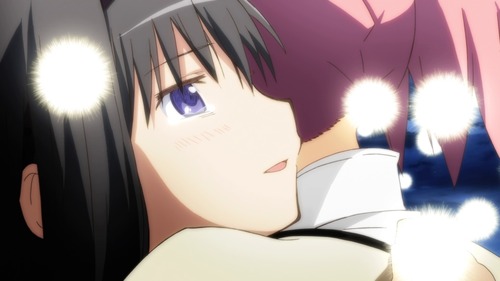Roll to dodge magical beam rifle
Let’s talk about roleplaying games for a moment.
For a little over a year now, I’ve been running a series of campaigns set loosely in the same world, one that started as a loose takeoff on Puella Magi Madoka Magica’s somewhere-after-modern urban take on the magical girl genre. I started out using the then-current third draft of Ewen Cluney’s Magical Burst, which is openly, and visibly, inspired in large part by the Madoka TV series. The system, to its credit, captures the twisted, surreal aesthetics of the show’s universe quite well, with explicit mechanics detailing the deleterious effects of magic on the player characters’ mental and physical state. It essentially takes the aspect of Madoka that has the most immediate impact on its viewers, and turns it into a fairly straightforward tabletop game.
Continue reading
This first “season” of my campaign went pretty well, all told, but I ended up eventually switching away from Magical Burst for a number of reasons. Some of the problems simply stemmed from the system itself still being in a beta state, meaning that the rules had some major oversights that I had to patch as we went along. This by itself actually wasn’t all that much of an issue; after all, I didn’t have any expectations that something still labeled “third draft” would be perfect, and the unofficial Magical Burst ReWrite project plugged some of the more glaring holes.
The apparent conflict between my style of play and MB’s was harder to resolve. As someone with an obvious narrativist bent, I could only scratch my head at some of the things that MB required die rolls for. The relationship mechanics, in particular, were a constant source of bafflement for both myself and my players. As a result, even though the player characters often had complicated ties to the NPCs and to each other, none of that ended up mattering much when it came to the dice-rolling aspects of the game.
MB, too, has a heavy emphasis on combat with witches (or youma, as the rulebook refers to them). Now, for a Madoka-like setting, this presents a narrative conundrum, because the original series portrays them mostly as forces of nature that the antagonists take advantage of, rather than as antagonists themselves. Their motivations are never all that clearly outlined, if they even exist to begin with. Witches mostly became a sideshow in my campaign as a consequence, existing so that the players had a chance to use their magic stats and pull off some cool moves every once in a while. Their real opponents were human more often than not, a case that MB handles awkwardly at best.
Perhaps the most fundamental problem, though, lay not with Magical Burst per se, but just the unavoidable challenge of adapting Madoka to a roleplaying setting in the first place. What makes Madoka’s story memorable is arguably a combination of two things. The first is the sheer scale of its main conflicts, which take place on an almost cosmological level. The battles we see aren’t just battles between people; they’re representations of battles between concepts – emotion against logic, emotion against itself – embodied as people. The second is Madoka’s willingness to constantly upend the apparent rules of its narrative, in a way that remains consistent with itself but not necessarily with the viewer’s expectations. Neither of these bode well for the ultimately character-driven, mechanical nature of your typical roleplaying game.
These issues by themselves weren’t completely fatal to the Magical Burst incarnation of my campaign. Ultimately, though, it ended up floundering in the face of some player disagreements anyway, so I took the opportunity to go back to the drawing board. I knew that I wanted a system that put emphasis on the human element, which was already the focus of most of the conflict in the game, and perhaps dialed down the importance of witches and other supernatural entities. This would push me away from Madoka’s aesthetic, but, after the experience of a few games, it was becoming clear to me that the tension between characters with opposing goals was the most interesting thing that had emerged from the campaign. The vivid imagery could be left to our imaginations.
Around that time, the suggestion of adapting Dogs in the Vineyard to our setting came up. Having run Dogs before, this was an idea that immediately appealed to me, especially in the way that its conflict system pushes characters’ motivations straight into the foreground. The biggest challenge, of course, was in swapping out the Mormon pioneer milieu of the original game for a magical girl facade, but this ended up being mostly a cosmetic change – fundamentally, the mechanics of the game haven’t been touched.
So far, I’m mostly satisfied with how things have turned out. What the current version of my campaign lacks in explicitly supernatural goings-on, it makes up for by more firmly grounding the characters’ respective struggles. The stronger sense of each character’s personality in turn informs the decisions the players make, and the plots that I construct. Most importantly, it feels less like a series of inexplicable things is happening to the characters; instead, they’re taking an active role in building the narrative, no matter how halting that might be from time to time. To me, that’s what makes a game interesting.
And, hey, I can always have a witch bite one of their heads off later.

